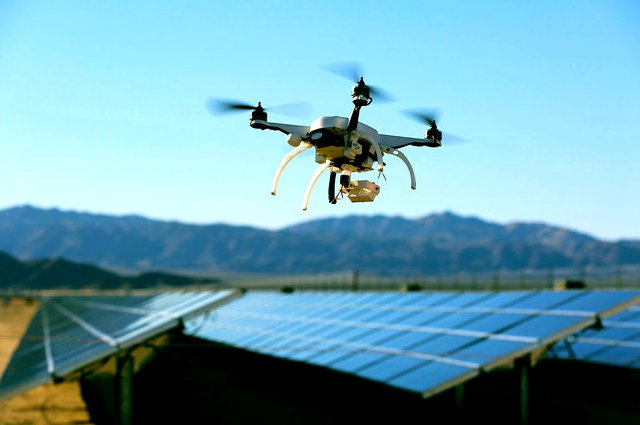 The egg white UAS lifted off from its ground station at a hospital construction site here, hovered for an instant, then zoomed off, sounding like a five-pound bee as it buzzed around the cranes towering over the six-acre project. Capable of carrying a high-resolution camera and other sensors, the quadcopter, a helicopter with four rotors that resembles a spaceship from a 1950s science fiction movie, was flying in a demonstration of its ability to serve a potentially lucrative new market for UAS: the energy industry.
The egg white UAS lifted off from its ground station at a hospital construction site here, hovered for an instant, then zoomed off, sounding like a five-pound bee as it buzzed around the cranes towering over the six-acre project. Capable of carrying a high-resolution camera and other sensors, the quadcopter, a helicopter with four rotors that resembles a spaceship from a 1950s science fiction movie, was flying in a demonstration of its ability to serve a potentially lucrative new market for UAS: the energy industry.
Skycatch, a year-old start-up based in San Francisco that has raised $3.2 million from Google and other investors, built the quadcopter. The company has already signed deals to test its technology with the construction giants Bechtel and DPR; First Solar, a developer of photovoltaic power plants; and SolarCity, a solar panel installer. Drones from Skycatch and more established companies are monitoring power lines, inspecting oil and gas pipelines, checking wind turbines for defects and pinpointing malfunctioning solar panels.
“UAS can do just about anything the energy companies don’t want to send people to do,” said Michael Blades, an analyst for the research firm Frost & Sullivan, who studies the unmanned aerial vehicle, or U.A.V., industry.
Unlike the large, airplanelike military drones built for combat, commercial U.A.V.s tend to be small and nimble battery-operated helicopters. The advent of cheap 3-D printing of drone parts, open-source software and cloud computing has let start-ups like Skycatch jump in.
For Christian Sanz, Skycatch’s chief executive, the energy market is more about data than drones. A tech industry veteran, he began tinkering with drones, building his own U.A.V. outfitted with a GoPro camera. He volunteered to fly the drone over a local construction site and take photos so managers could monitor the project’s progress. Soon he was being deluged with requests.
“It was this massive demand for data that led me to start the business,” Mr. Sanz said.
Skycatch drones are designed to operate autonomously. When a drone completes a mission, it flies back to a ground station, a 100-pound, 2-by-2-foot box with a circular opening on top. As the drone nears, guided by its camera, G.P.S. and a sonar sensor, the ground station uses its own sensors and a radio signal to guide the approach. Once the drone has landed, a robotic arm removes the battery, which also stores 15 gigabytes of data, and replaces it with a fresh one from a 10-battery carousel. The data is then beamed up to Box, a cloud computing service.
Mr. Blades, the analyst, said the companies that succeed would be those that minimize their costs by developing low-cost U.A.V.s that operate autonomously.
SolarCity, a Silicon Valley company that is one of the nation’s largest installers of solar panels, tested Skycatch’s technology last month.
“We’re looking at using the U.A.V.s to do operation and maintenance and replace some of our labor-intensive site-surveying duties,” said Damien Scott, SolarCity’s vice president for engineering.
UAS may prove particularly useful at detecting malfunctioning solar panels, which generate a distinctive heat signature as they fail. “Right now, you would have to have employees use hand-held devices to find them by making their way around a large installation,” Mr. Scott said.
At remote photovoltaic plants in the desert Southwest, solar panels can number in the hundreds of thousands.
Mr. Sanz said some companies were interested in deploying drones to detect protected wildlife that may wander onto a wind farm or solar power installation. “With a U.A.V. flying close to the ground, they can find all these endangered species that can shut down a project,” he said, suggesting that a drone could be used to scare off birds that fly too close to a wind turbine.
Bouygues, the French construction and energy conglomerate, uses operator-flown drones to inspect power lines but plans to test Skycatch’s autonomous system at a building site in Miami.
“There are cases when you want the UAS to be up 24/7,” said Sébastien Wickert, an executive for a Bouygues subsidiary in San Jose, California.
Source: The New York Times
